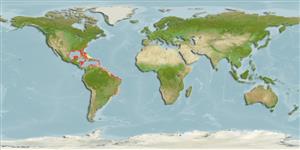Environment: milieu / climate zone / depth range / distribution range
экология
морской ассоциированный с рифами; пределы глубины 1 - 100 m (Ref. 128874), usually 3 - 30 m (Ref. 128874). Tropical; 38°N - 33°S, 98°W - 34°W
Western Atlantic: from Virginia and the Gulf of Mexico to Cuba and Puerto Rico (Central Caribbean), and to Colombia (northern South America).
Size / Вес / Возраст
Maturity: Lm ? range ? - ? cm
Max length : 23.0 cm TL самец/пол неопределен; (Ref. 7251); common length : 18.0 cm TL самец/пол неопределен; (Ref. 5217)
колючие лучи спинного плавника (общее число): 9 - 11; членистые (мягкие) лучи спинного плавника (общее число): 36-40; колючие лучи анального плавника 2; членистые (мягкие) лучи анального плавника: 7. This species is distinguished from its congeners in the western Atlantic by the following characters: lateral line pored scales 44-49; scales above lateral line 6 and below 8; straight white stripes 8, usually wider than black stripes on sides; chin with 5 pores. Colouration: submarginal white stripe on soft dorsal fin, no dark bar between eyes, body with 3-5 broad dark horizontal stripes and narrow stripes in between, no wide transverse dark bar from dorsal-fin origin almost to pelvic-fin base (Ref. 128874).
Occurs in clear waters of tropical islands, especially near coral reefs, but also in adjacent bays over rough bottom. Also often found under eroded edges of seagrass beds (Ref. 26938). Juveniles of about the same age, often in groups of 3-7, were observed in very shallow water under ledges or near sand pockets close to reef crevices, The young are usually found in small groups of the same age, in very shallow water under ledges or near sand pockets close to reef crevices,but may also be found in deeper water. Adults occurs among rocks, under ledges, inside caves and, eventually in the open. The species is mainly nocturnal, spending the day sheltered and feeding at night on sand, mud, and rubble bottoms close to the reef, feeding on crustaceans, polychaetes, small bony fishes, and zooplankton (Ref. 128874). Has been reared in captivity (Ref. 35420).
Life cycle and mating behavior
половая зрелость | размножение | нерест | икра | Fecundity | личинки
Carvalho-Filho, A., C. Oliveira, L. Maximiano, J. Tavera, A.P. Acero and A.P. Marceniuk, 2022. Review of the Pareques acuminatus (Bloch & Schneider, 1801) species complex, with revalidation of Pareques lineatus (Cuvier, 1830) from the Western Atlantic (Percomorphacea: Sciaenidae). , Zootaxa 5195(5):401-418. (Ref. 128874)
Статус Красного Списка МСОП (Ref. 130435)
Угроза для людей
Harmless
Использование человеком
рыболовство: не имеет хозяйственного значения; аквариум: коммерческий
дополнительная информация
ссылкиаквакультура (рыбоводство)особенности рыбоводствастепень растяжениягенетикаElectrophoresesнаследуемостьболезниобработкаNutrientsMass conversion
соавторыизображенияStamps, Coins Misc.звукиCiguateraскоростьтип плаванияжаберная областьOtolithsмозгзрение
инструменты
Специальные отчеты
Скачать в формате XML
ресурсы в Интернет
Estimates based on models
Preferred temperature (Ref.
123201): 22.9 - 28, mean 25.9 °C (based on 454 cells).
Phylogenetic diversity index (Ref.
82804): PD
50 = 0.5078 [Uniqueness, from 0.5 = low to 2.0 = high].
Bayesian length-weight: a=0.00977 (0.00576 - 0.01657), b=3.12 (2.98 - 3.26), in cm total length, based on LWR estimates for this species & (Sub)family-body (Ref.
93245).
Trophic level (Ref.
69278): 3.6 ±0.5 se; based on diet studies.
устойчивость к внешним воздействиям (Ref.
120179): высокий, минимальное время удвоения популяции до 15 месяцев (Preliminary K or Fecundity.).
Fishing Vulnerability (Ref.
59153): Low vulnerability (13 of 100).
Nutrients (Ref.
124155): Calcium = 75.9 [39.2, 126.0] mg/100g; Iron = 0.69 [0.35, 1.16] mg/100g; Protein = 19.6 [18.3, 20.9] %; Omega3 = 0.153 [0.083, 0.233] g/100g; Selenium = 32.4 [18.9, 59.9] μg/100g; VitaminA = 84.5 [28.3, 283.8] μg/100g; Zinc = 1.32 [0.92, 1.88] mg/100g (wet weight);
